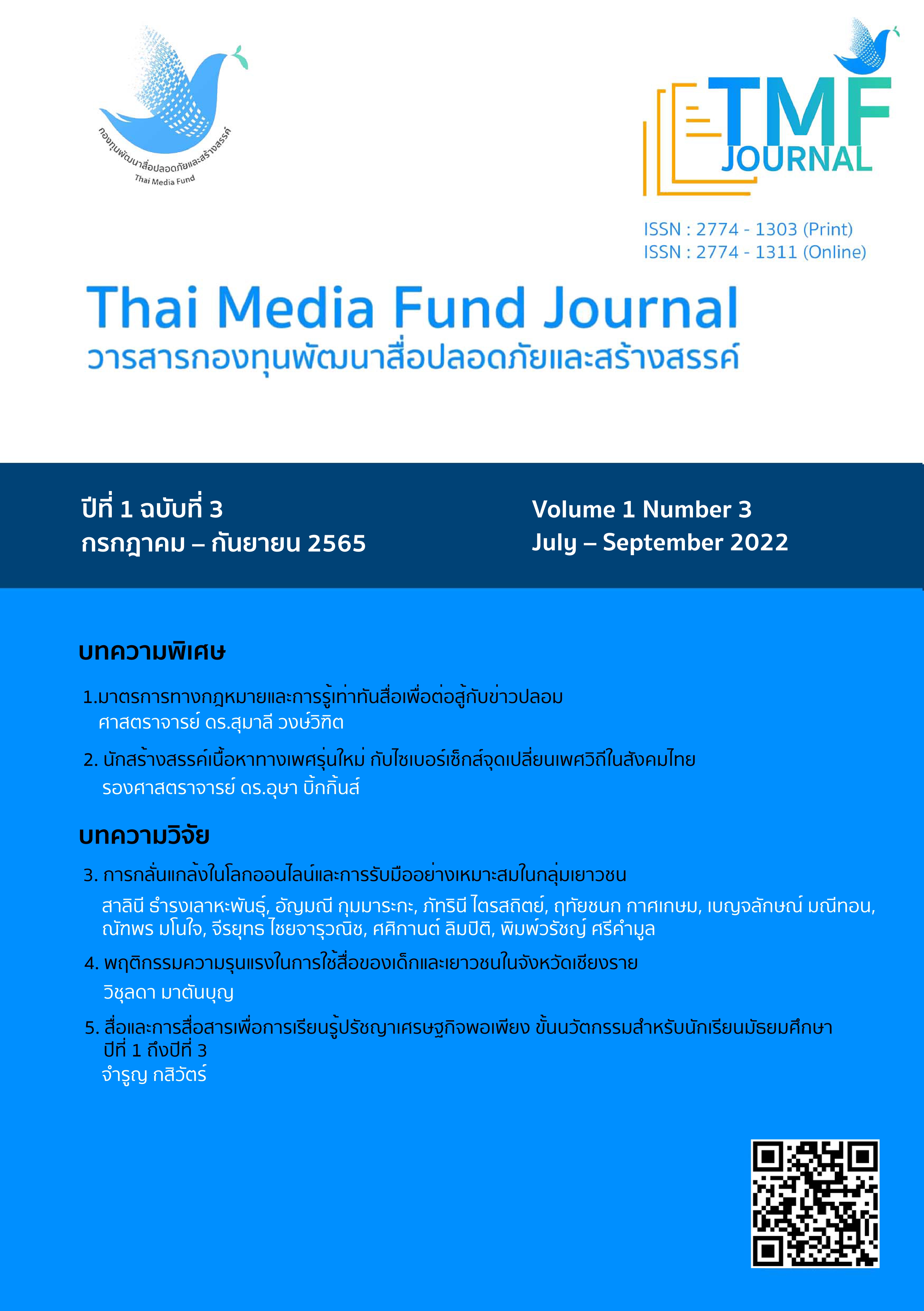สื่อและการสื่อสารเพื่อการเรียนรู้ปรัชญาของเศรษฐกิจพอเพียง ขั้นนวัตกรรมสำหรับนักเรียนมัธยมศึกษาปีที่ 1 ถึงปีที่ 3
Main Article Content
บทคัดย่อ
งานวิจัยนี้มีวัตถุประสงค์ 1) เพื่อศึกษาลักษณะของสื่อที่เป็นตัวสินค้าที่จะให้นักเรียนมัธยมศึกษาปีที่ 1 ถึงปีที่ 3 ได้เรียนรู้หลักปรัชญาเศรษฐกิจพอเพียง ขั้นที่ 3 ขั้นนวัตกรรม 2) เพื่อศึกษาวิธีการสื่อสารของครูนักเรียนที่จะสื่อสารกันในหลักปรัชญาของเศรษฐกิจพอเพียงขั้นที่ 3 ขั้นนวัตกรรม การวิจัยครั้งนี้เป็นการวิจัยเชิงคุณภาพโดยการสัมภาษณ์ กลุ่มเป้าหมาย 17 คน เลือกแบบเจาะจงจากกลุ่มนักศึกษาหลักสูตรผู้นำการพัฒนาที่ยั่งยืน (นพย.) ของมูลนิธิชัยพัฒนา โดยใช้เทคนิคการตรวจสอบผลการสัมภาษณ์ โดยเทคนิคเดลฟาย 3 รอบ และตรวจสอบผลว่าตรงกับหลักปรัชญาของเศรษฐกิจพอเพียงหรือไม่ โดยผู้ทรงคุณวุฒิ จำนวน 3 ท่าน มีประสบการณ์สูงโดยเลือกแบบเจาะจง ผลการวิจัยพบว่า 1) ลักษณะของสื่อที่เป็นตัวสินค้าอันดับที่ 1 ควรมีลักษณะให้นักเรียนร่วมคิด ร่วมทำ ร่วมผลิต ออกมาเป็นสินค้านวัตกรรมของโรงเรียน 2) การสื่อ ควรมีการสื่อสารโดยใช้สื่อหลายรูปแบบทั้งออนไลน์ ประชุมผู้ปกครอง ระหว่างโรงเรียนกับลูกค้าให้นักเรียนได้เรียนรู้ และทุกประเด็นที่พบและถูกยืนยันสอดคล้องกับหลักปรัชญาเศรษฐกิจพอเพียงทุกข้อ
Article Details

อนุญาตภายใต้เงื่อนไข Creative Commons Attribution-NonCommercial-NoDerivatives 4.0 International License.
เอกสารอ้างอิง
Bamrungphakdi, T., & Ruyuenyong, W. (2019). Strategies for managing schools with international standards according to the philosophy of sufficiency economy. under the office of the secondary education service area, region 25. Journal of MCU Buddhapanya Review, 4(1), 127-136.
Chaemchoy, S. (2012). Innovative Ideas for school administration in the 21st century. Journal of Education Naresuan University, 14(2), 117-128.
Chaisanit, S. (2010). Innovation and technology. Retrieved from http://it.east.spu.ac.th/informatics/admin/knowledge/A307Innovation%20and%20Techno logy.pdf
Chanruam, R. (2017). Dual system school management innovation based on the concepts of career-related programme. Dissertation of Doctorate of Education Administration, Educational Policy Management and Leadership, Doctor of Education, Education, Chulalongkorn University.
Dangpirom, S. (2019). Educational administration by using new innovations. in the 21st Century. In School 3rd National Research “Conference Graduate School Conference 2019”, 3(1), 170-178.
Department of Local Government Promotion. (2016). Local sufficiency school: LSS. Retrieved from http://www. nanlocal.go.th/doc_news/doc220171213214509.pdf
Fagerberg, J. (2005). The oxford handbook of innovation. Oxford: Oxford University Press.
Keeley, L. (2015). Ten types of innovation: The discipline of building breakthroughs. Hoboken, NJ: John Wiley & Sons.
Ministry of Education. (2017). Learning center according to the sufficiency economy philosophy in education titled “educational institutions, model of learning activities and management according to the sufficiency economy philosophy “sufficiency education institution” year 2017. Retrieved from http://www.moe.go.th/moe/th/news/detail. php?NewsID=52116&Key=news19
Office of the Royal Development Projects Board (ORDPB). (2016). “Disseminating knowledge according to royal initiatives”, volume 2 “Sufficiency economy”. Bangkok: Office of the Royal Development Projects Board.
Oita, H. (2012). One village one product of Oita, a small province in Japan, the model of ‘one community, one product’. Retrieved from https://urbancreature.co/oita-ovop-japan/
Philosopher of the Land. (2020). Philosopher of sufficiency economy. Retrieved from http://www3.moac.go.th/ philosopher-philosopher-suffice
Puenpasuk, P. (2019). Driving the philosophy of sufficiency economy into basic education Ban Muengkong school Chiangdao district, Chiangmai province. Research and Development Journal of Buriram Rajabhat University, 14(2), 148-155.
Safe and Creative Media Development Fund Act. (2015, March 26). Government gazette. Page 30. Retrieved from https://www.m-culture.go.th/surveillance/files/835/58/safe-creative-media-law58.pdf
Saenglert Uthai, C. (2015). Research instrument. Journal of Graduate School Sakon Nakhon Rajabhat University, 12(58), 13-24.
Tantivejkul, S. (2016). Ecotourism project in Chaipattana-Thai Red Cross area. (Ban Thung Rak), Kuraburi subdistrict, Kuraburi district, Phang Nga province. Executive News of the Chaipattana Foundation. Retrieved from https://www.chaipat.or.th/progress-report/899-manager-chaipattana-news/9100-18-2561.html
Technologychaoban. (2021). Live in the sufficiency economy, planting vegetables, raising chickens in a yard. regardless of the economy, the family was able to survive without being affected. Retrieved from https://www.technology chaoban.com/livestock-technology/article_7436
Timothy, M. (2011). Organizational structure effect on communication efficiency for management information system supported organizations: A delphi study. Doctoral Dissertation, Management in Organizational Leadership with a Specialization in Information Systems and Technology, University of Phoenix.
Thammatasananon, S. (2017). The development of educational administration in the basic school level by the participation approach of the basic education committee, under the jurisdiction of Kalasin primary educational service area office 2. Journal of Education, Mahasarakham University. 17(3), 41-52.
Thanomsing, L. (2016, August 18). The introduction of the sufficiency economy philosophy to the Kuraburi Chaipattana Pittayakom school, Kuraburi sub-district, Kuraburi district, Phang Nga province [interview]. Member and Deputy Secretary-General of the Chaipattana Foundation, Batch 1 of Sustainable Development Leaders (SDL1).
Turner, K. et al. (2018). The pedagogical situation fostering 21st century skills of nursing students at Boromarajonani college of nursing, Chon Buri. Nursing Journal of the Ministry of Public Health, 28(1), 127-137.
Wiroonraj, B. (2017). Guidelines for human resource management. Chachoengsao: MN Computer Offset.


